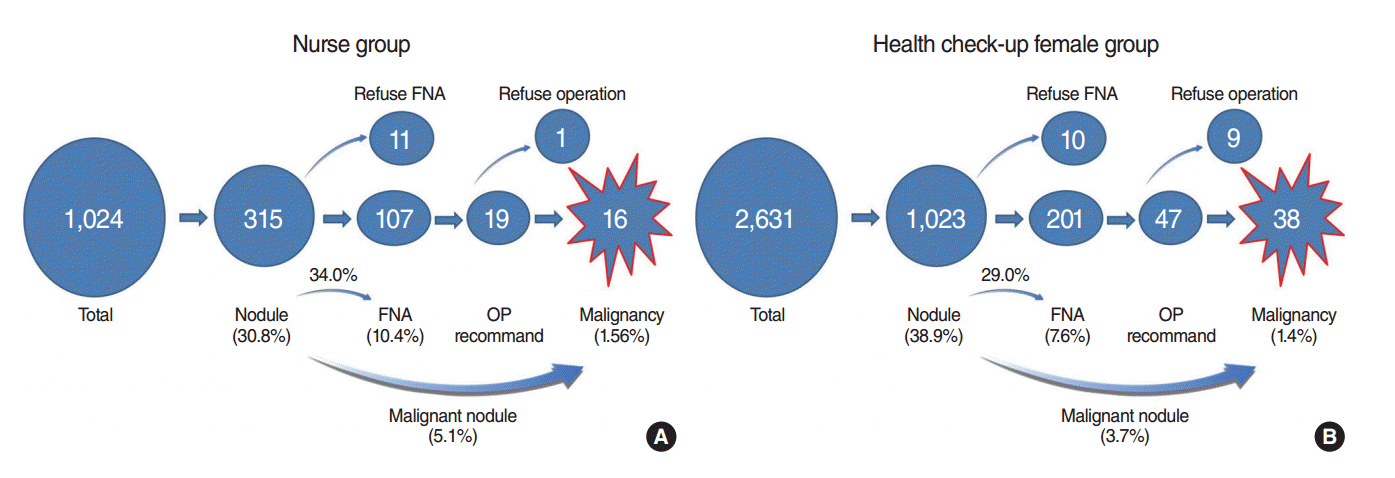1. Bomeli SR, LeBeau SO, Ferris RL. Evaluation of a thyroid nodule. Otolaryngol Clin North Am. 2010; Apr. 43(2):229–38.

2. Gharib H, Papini E, Paschke R, Duick DS, Valcavi R, Hegedus L, et al. American Association of Clinical Endocrinologists, Associazione Medici Endocrinologi, and European Thyroid Association Medical guidelines for clinical practice for the diagnosis and management of thyroid nodules: executive summary of recommendations. Endocr Pract. 2010; May-Jun. 16(3):468–75.

3. Hegedus L. Clinical practice: the thyroid nodule. N Engl J Med. 2004; Oct. 351(17):1764–71.
4. Tonacchera M, Pinchera A, Vitti P. Assessment of nodular goitre. Best Pract Res Clin Endocrinol Metab. 2010; Feb. 24(1):51–61.

5. Brander A, Viikinkoski P, Nickels J, Kivisaari L. Thyroid gland: US screening in a random adult population. Radiology. 1991; Dec. 181(3):683–7.

6. Brander A, Viikinkoski P, Tuuhea J, Voutilainen L, Kivisaari L. Clinical versus ultrasound examination of the thyroid gland in common clinical practice. J Clin Ultrasound. 1992; Jan. 20(1):37–42.

7. Ezzat S, Sarti DA, Cain DR, Braunstein GD. Thyroid incidentalomas: prevalence by palpation and ultrasonography. Arch Intern Med. 1994; Aug. 154(16):1838–40.

8. Rojeski MT, Gharib H. Nodular thyroid disease: evaluation and management. N Engl J Med. 1985; Aug. 313(7):428–36.
9. Tan GH, Gharib H. Thyroid incidentalomas: management approaches to nonpalpable nodules discovered incidentally on thyroid imaging. Ann Intern Med. 1997; Feb. 126(3):226–31.

10. Vander JB, Gaston EA, Dawber TR. The significance of nontoxic thyroid nodules: final report of a 15-year study of the incidence of thyroid malignancy. Ann Intern Med. 1968; Sep. 69(3):537–40.
11. Choi SY, Woo SH, Shin JH, Choi N, Son YI, Jeong HS, et al. Prevalence and prediction for malignancy of additional thyroid nodules coexisting with proven papillary thyroid microcarcinoma. Otolaryngol Head Neck Surg. 2013; Jul. 149(1):53–9.

12. Woo SH, Kim KH, Kim RB. Thyroid nodules with repeat nondiagnostic cytologic results: the role of clinical and ultrasonographic findings. World J Surg. 2015; Jul. 39(7):1721–7.

13. Chung WY, Chang HS, Kim EK, Park CS. Ultrasonographic mass screening for thyroid carcinoma: a study in women scheduled to undergo a breast examination. Surg Today. 2001; 31(9):763–7.

14. Belfiore A, La Rosa GL, La Porta GA, Giuffrida D, Milazzo G, Lupo L, et al. Cancer risk in patients with cold thyroid nodules: relevance of iodine intake, sex, age, and multinodularity. Am J Med. 1992; Oct. 93(4):363–9.

15. Francis GL, Waguespack SG, Bauer AJ, Angelos P, Benvenga S, Cerutti JM, et al. Management guidelines for children with thyroid nodules and differentiated thyroid cancer. Thyroid. 2015; Jul. 25(7):716–59.

16. Gasent Blesa JM, Grande Pulido E, Provencio Pulla M, Alberola Candel V, Laforga Canales JB, Grimalt Arrom M, et al. Old and new insights in the treatment of thyroid carcinoma. J Thyroid Res. 2010; Apr. 2010:279468.

17. Papini E, Guglielmi R, Bianchini A, Crescenzi A, Taccogna S, Nardi F, et al. Risk of malignancy in nonpalpable thyroid nodules: predictive value of ultrasound and color-Doppler features. J Clin Endocrinol Metab. 2002; May. 87(5):1941–6.

18. Cho JK, Woo SH, Park J, Kim MJ, Jeong HS. Primary squamous cell carcinomas in the thyroid gland: an individual participant data meta-analysis. Cancer Med. 2014; Oct. 3(5):1396–403.

19. Woo SH, Kim JP, Park JJ, Shim HS, Lee SH, Lee HJ, et al. Comparison of natural drainage group and negative drainage groups after total thyroidectomy: prospective randomized controlled study. Yonsei Med J. 2013; Jan. 54(1):204–8.

20. Covens P, Berus D, de Mey J, Buls N. Mapping very low level occupational exposure in medical imaging: a useful tool in risk communication and decision making. Eur J Radiol. 2012; Sep. 81(9):e962–6.

21. Igaki H, Nakagawa K. Radiological clinical practice and its safety in hospital. Nihon Rinsho. 2012; Mar. 70(3):475–8.
22. Sont WN, Zielinski JM, Ashmore JP, Jiang H, Krewski D, Fair ME, et al. First analysis of cancer incidence and occupational radiation exposure based on the National Dose Registry of Canada. Am J Epidemiol. 2001; Feb. 153(4):309–18.

23. Zabel EW, Alexander BH, Mongin SJ, Doody MM, Sigurdson AJ, Linet MS, et al. Thyroid cancer and employment as a radiologic technologist. Int J Cancer. 2006; Oct. 119(8):1940–5.





 PDF
PDF Citation
Citation Print
Print



 XML Download
XML Download